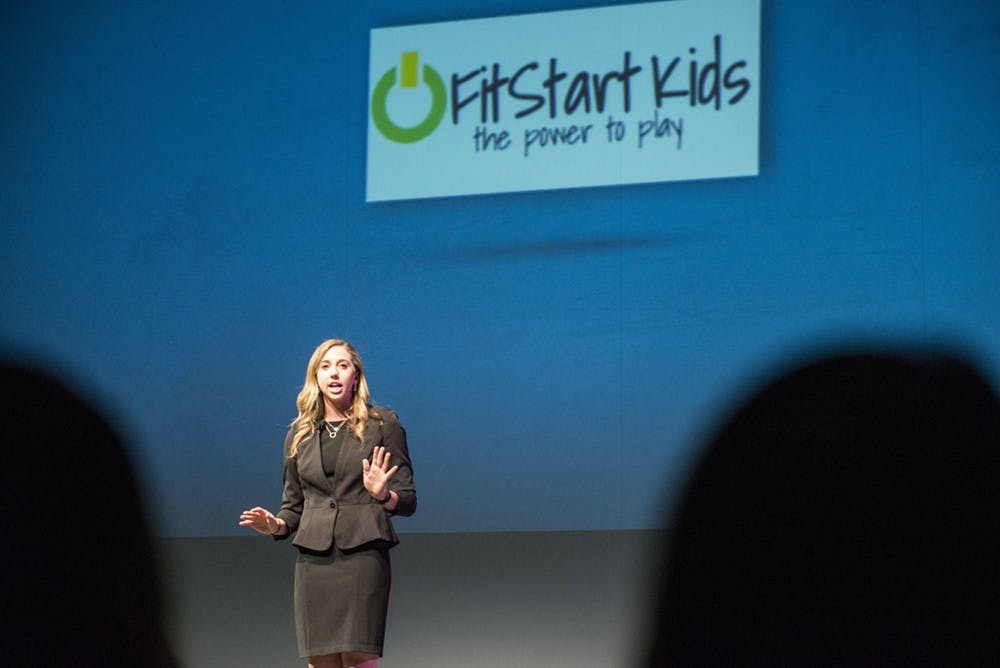A new ASU program intends to get kids off the couch and play outside by incentivizing exercise with video games.
FitStart Kids is tackling the growing issue of childhood obesity throughout the U.S.
Biomedical engineering junior Courtney Van Bussum created FitStart Kids three years ago to change the landscape of childhood activity by combining wearable technology and video gaming to get kids active. The combination uses step count and calorie usage to measure activity goals.
After reaching certain goals using the activity tracker, the child can sync his or her tracker to the FitStart Kids website and receive rewards. The rewards are called FS game coins that can be used to upgrade or get bonus content on various video games on today’s leading consoles.
Bussum, the oldest of five kids, witnesses her siblings playing video games and knows how hard it is to get young children outside rather than sitting in front of a television all day.
Bussum started her program by experimenting with her siblings and said they enjoyed the incentive aspect of the program with one of their games.
“My siblings play Disney Infinity, so they get spark points or skill level points,” Bussum said. “The FitStart Kids points can be exchanged for spark points in the game so the character can get a new upgrade.”
FitStart Kids combines wearable tech and video games to incentivize activity with gaming currency. Learn more @statepress
— Joey Hancock (@Joey_Hancock) August 19, 2015
The FitStart Kids portal will be web-based and will be the place to go to link one's Fitbit activity tracker in order to receive the game points.
“The FitStart Kids portal will all be web-based initially as a website and then (we will) make it more mobile,” she said. “You can log on and there will be directions to set up your Fitbit and create a profile, and, overtime, you log onto your profile it will be updated through your Fitbit.”
Bussum will add a social component in the future to give the kids in the program a mentor or coach who helps them achieve their weight loss goals.
“We are looking at making a social component also so kids will get a coach or mentor and be on a team that compete against other teams on things like step challenge on the platform,” Bussum said.
Working with members of ASU staff and mentors from the medical world has helped legitimize FitStart Kids as a real way for children to lose weight while offering a new way of incentivizing to get the children motivated in the first place.
Brent Sebold, director of the Startup Center within the Ira A. Fulton Schools of Engineering, said the most difficult part coming up for Bussum and FitStart Kids will be getting validation that this program is a viable solution for children and their families to fight the weight loss battle.
“It’s a great concept and she’s not alone,” he said. “The challenge Courtney is going to have is to go out and validate that business model that is repeatable and scalable. Once she has a group of concepts, the hope is that she will garner enough data to prove this is a useful intervention and show the parents or kids who have benefited from the program.”
Elizabeth Yurth, a non-surgical musculoskeletal specialist from Colorado, has been helping Bussum give credibility to the FitStart Kids program.
“I’ve been helping with consulting in what is realistic, like eating better and not just (drinking) soda, but to teach kids and get them interested in eating healthier and not just counting calories,” she said.
Yurth said the program benefits children.
"All kids like technology, so I have a 10-year-old patient who is on the chubby side and we got him a Fitbit tracker and it’s amazing how much it has motivated him to hit 10,000 steps a day," she said. "He told me yesterday that he asked if he could walk to get ice cream to meet his steps cause he hadn’t quite reached it for the day yet.”
The benefit of having something tangible to show the kids that they are achieving something more than just weight loss plays a role in how the kids interact and get excited about the program.
“Even in the 8-year-old population, it is something they can look at and we know that those simple motivators in kids can go a long ways,” Yurth said. “It’s like a star chart when your kids are doing chores; it is something they can look at and get something out of it.”
For physicians across the country, Yurth said helping children lose weight is a never-ending battle and not having enough time with patients to help counsel them is a major reason it is so difficult to help the children who need it.
"I have these patients come in and I know I need time to counsel them on how to get this kid to lose weight and I don’t have time," she said. "If I can just write out a prescription for this youngster to start the FitStart program and then they take it from there, that would be huge.”
Related Links:
ASU startup reinvents shovel, digs up funds for venture
ASU Polytechnic Startup Village creates a residential community for like-minded entrepreneurs
Reach the reporter at jshanco2@asu.edu or follow @joey_hancock on Twitter.
Like The State Press on Facebook and follow @statepress on Twitter.




